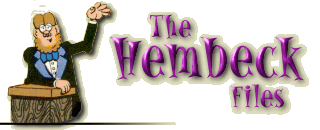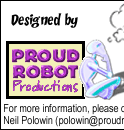These Hembeck strips ran over twenty years ago, so many of you are seeing them for the first time. Brand awareness being as important as it is in a marketing context, DC execs have always been very cautious about costume changes over the years, so it's likely that you're recognizing most of the heroes and other characters fairly readily.
That being said, I'm sure that some of you are asking yourselves, "Okay, I recognize Doctor Fate and Wildcat from the current 'JSA' title, but who's the chick with the big...um...hair?"
Fair question. She's called Power Girl.
"Who?"
Power Girl. You know, the Earth-2 version of Supergirl.
"Supergirl? You mean the one that Peter David's been writing, with the skateboard? Or the protoplasmic blob that liked to play tonsil hockey with Lex Luthor? And what do you mean by 'Earth-2', anyway?"
History lesson time, kids - everyone sit up straight and spit out your gum, because there's gonna be a quiz later.
(What's really frightening is that I'm actually not sure which of these two - multiple Supergirls versus multiple Earths - is going to be easier to explain.)
In the beginning, there was Superman, leaping over tall buildings, racing locomotives, and repeatedly violating sections of the U.S. Constitution in the pursuit of justice by way of coercion and Lois Lane's knickers. Sales were brisk, and all was sufficiently profitable in the world to justify launching a new hero: Batman. Before you could say "Holy imitation, Batman!," the newstands were overrun by heroes of all shapes and sizes, in what we lovingly refer to as the 'Golden Age' of comics. The Flash, Green Lantern, The Spectre, Starman, Wonder Woman, Hourman, and others soon fought for rack space alongside the two big guns, and were also brought together as the Justice Society of America, both to thwart villainy as a team and to make fun of Johnny Thunder.
Sadly, all good things must come to an end, and so too went the Golden Age. The only heroes in the DC pantheon to maintain an unblemished publishing schedule following the downturn in the super-hero market were the so-called Big Three: Superman, Batman, and Wonder Woman (the latter apparently only to thwart a copyright reversion back to the estate of WW creator William Moulton Marston).
But then came the light at the end of the tunnel! DC introduced a new version of The Flash in the pages of Showcase, complete with new costume and new secret ID. DC followed this success with new versions of several other JSA characters, including Green Lantern and The Atom, and all soon became bright and shiny in the world of super-heroes once again. Other heroes were also brought back into play, many of them without any significant changes in concept or costume.
Then, editor Julius Schwarz had a brainstorm that, depending on your outlook, was either brilliant or deranged. In one now-legendary story (Flash #123), he had the new-and-improved Flash cross a "vibrational barrier" to meet up with his older counterpart. In a sequence of monumental hubris, the younger Flash designated his world as 'Earth-1', relegating the name of 'Earth-2' to the world of the older speedster. Conceptually, the collective DC editorialship placed all of the golden age heroes, including all members of the Justice Society, on Earth-2, leaving Earth-1 for the newer heroes. How do you deal with heroes like Superman and Batman, who were obviously golden age characters but who were also teaming up with the newer heroes? Simple - there's a Superman on each Earth. And a Batman. Wonder Woman, too. Can't forget Green Arrow. And so on, and so on.
Let's flash ahead a few years now. Things have been going swimmingly with the two parallel Earths, with annual reunions between the JSA and the Justice League, the Flashes are buddy-buddy, and both Green Lanterns have had ample opportunities to compare notes on the ludicrous and arbitrary weaknesses of their respective rings. "Really? Doesn't work on anything made of wood? Get this - mine can't touch anything colored yellow! How lame is that?"
Now, at some point in the mid-seventies, someone got it into their heads to resurrect the JSA, and without even having to say "cei-u", All-Star Comics was back on the schedule, just in time for the DC implosion. The revived series lasted about ten issues, long enough to set the stage for what would become a recurring theme in the DC universe: passing the heroic torch on to younger generations.
On that note, let's quickly review the Girl of Steel's history in the DC universe. Superman editor Mort Weisinger, in an odd habit of not leaving well enough alone, kept introducing more and more elements of Superman's Kryptonian history into the family of Superman titles. It's difficult to fault Mort for doing this; the fans ate it up, regardless of how much it diminished that sole-survivor-of-a-doomed-planet motif.
Superman's first-cousin Kara was introduced as Supergirl in the early 1950s, and was a moderately popular character over the years, even kicking the Legion of Super-Heroes out of Adventure Comics at one point. It just goes to show you that no amount of bouncing, matter-eating, lightning-firing, illusion-casting, shrinking, growing, or karate chopping can stand up to a cute blonde in a mini-skirt.
That maxim carried over to the brand new incarnation of All-Star Comics. The Earth-2 version of Supergirl, called Power Girl, had already been introduced in the pages of 'Showcase', so including her as a next-generation member of the JSA was a no-brainer. Besides, her costume was even skimpier than Supergirl's ever was - basically a white one-piece bathing suit with boots and a cape.
But, lo, there came a crisis. An infinite one. All of the assorted Earths of the DC multiverse melded together like some kind of cosmic fusion thing. Earth-1, Earth-2, Earth-Q, Earth-S, Earth-Prime, etc., were all brought together to form one singular continuity. Others were destroyed outright, including - hopefully - all of the ones with anthropomorphic versions of the DC pantheon.
So, what happens when you condense worlds with multiple versions of the same characters? You need to start revising your official continuity. With Power Girl being the Kara-come-lately, you might expect her to be the one who's history needed to be re-written. Well, you'd be half-right. In one of many efforts to indulge John Byrne, DC agreed that the new continuity would not have any Supergirls at all, at least none who were also Superman's cousin. Bottom line - each of them required a new origin.
When the dust finally settled, Power Girl had herself some brand-spankin'-new Atlantean-based roots, and Supergirl was re-introduced as a protoplasmic artificial life-form from a so-called 'pocket universe' that starts to make sense only if you're a Legion fanatic.
Apparently, Peter David has introduced yet another version of Supergirl, but I've only ever seen the house ads for the book and really don't know much more than that. If somebody wants to provide the scoop in this one, I'll happily append it here.
So there you have it. Now you know who all of the characters in this JSA-influenced Hembeck strip are. Aren't you glad you asked?
Wow. That was fast.
The digital ink has been dry on this one for barely 24 hours, and already someone has stepped up to provide info on Peter David's version of Supergirl. Man, I love this medium...
Take it away, Terence Chua:
Peter David took the protoplasmic Supergirl and shook things up by merging
her with a dying human girl named Linda Danvers (and together... they're
detectives! No, I'm kidding) - yes, it's a cute tribute to the old days. He
even named her town Leesburg. They are a merged identity, not a Captain
Marvel/Billy Batson deal. Linda/Supergirl is now discovering that she is, in
actuality, an Earth-born angel, and manifests flaming wings from her back
when using her angelic powers. It's a really good book, and David manages to
capture the spirit of the Kara we used to know and love.
Thanks, Terence!
- NP









